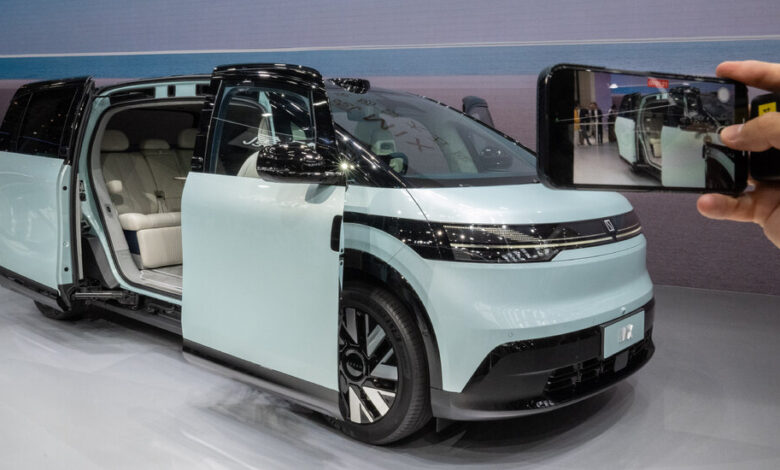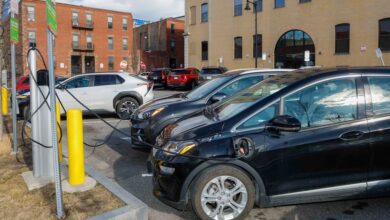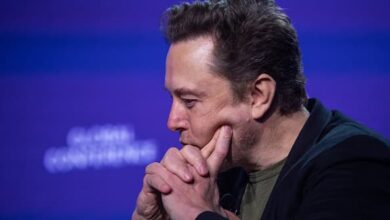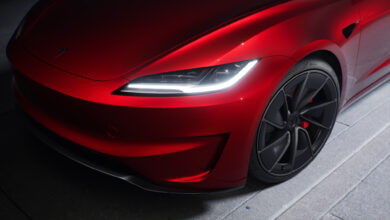China’s Electric Cars Keep Improving, a Worry for Rivals Elsewhere

Automakers in China are building a new generation of bigger, more technologically advanced and competitive electric cars, threatening to leap further ahead of their global rivals as they step up exports around the world.
The dozens of car companies operating in China plan to put 71 new battery electric models on sale this year. Many new models have taller hoods for a bolder appearance and more storage space. The cars have bigger tires that improve braking. The seats are thicker and more comfortable. The batteries are ever smaller, more powerful and quicker to recharge.
The changes are aimed at making the cars even more appealing for customers in China and more competitive abroad. Along with plug-in hybrid cars, battery electric cars are taking sales away from gasoline-powered cars and their manufacturers.
The approvals show the Chinese government’s eagerness to push the development of self-driving vehicles, which are widely seen as central to future competitiveness in the car industry. The technology is more compatible with battery electric cars than with plug-in hybrids or gasoline-powered cars, and Chinese companies are trying to catch up with Tesla, the leader in these systems.
In the United States, Tesla’s so-called Autopilot feature has been the subject of a series of government safety investigations. But in China, regulators and the general public have tended to see the technology as safer than relying on human drivers.
Chinese automakers have been investing heavily in driver-assistance software. An electric car “is becoming a robot on wheels,” said Frank Wu, the vice president of design at Jiyue. The company is a joint venture of Zhejiang Geely, a Chinese automaker, and Baidu, one of China’s main artificial intelligence companies and Tesla’s partner in its self-driving efforts in China.
Better batteries and falling costs underpin China’s push in electric cars. CATL, based in southeastern China and the world’s largest manufacturer of electric car batteries, announced last week at the Beijing auto show that a 10-minute charge of its newest battery would give a range of 370 miles. A 30-minute full charge would give a range of 620 miles, the company said.
Achieving these distances involves extremely high-precision chemistry and engineering and “putting each nano-particle in the right place,” said Gao Huan, the chief technology officer of CATL’s electric car business.
The advances have meant automakers can use smaller batteries, freeing up space in cars’ interiors, or they can keep the battery the same size and achieve greater range.
Much of the extra space is going into larger back seats with more legroom.
“We’re going to put more focus on the backseat — we want to make it more appealing,” said Wang Tan, the general manager of design at XPeng Motors, a Chinese electric car manufacturer.
Manufacturers of electric vehicles used to put a priority on keeping cars as light as possible, because weight is what mostly matters for how far a car can go before needing a recharge. But more powerful batteries now allow electric vehicles to be taller and heavier.
Bigger front ends create a luxurious appearance that taps into many buyers’ admiration of sport utility vehicles, said Kris Tomasson, vice president of design at Nio.
“A higher front has that prestige,” he said.
Chinese automakers are also embracing designs with more edges, like a blue-green Denza Z9GT sedan displayed at the show by BYD. They are shifting away from lightweight but costly aluminum and building cars with a higher proportion of heavier but cheaper steel alloys.
Aluminum body panels need to be more curved and do not allow for the sharper lines possible with a return to steel, said Stefan Sielaff, Geely’s vice president of global design. The effect is to make the cars more visually striking as automotive fashions shift away from the rounded shapes on previous electric cars.
Customers overseas as well as in China are getting pickier. Many are buying plug-in hybrids instead of cars powered only by batteries, although the markets for both are still growing in China.
Not all the electric cars at the Beijing show are bigger and roomier. Xiaomi, a Chinese producer of inexpensive smartphones, displayed its first electric car, the SU7 sports sedan. The tech company has made a move into the car market that Apple has mulled for many years without undertaking.
The SU7 looks almost identical from the outside to a Porsche Taycan electric car. But it costs less than a fifth of a Taycan, which ranges in China from $140,000 to $275,000.
Lei Jun, the chief executive of Xiaomi, was followed by a crowd of admirers as he walked around the auto show.
He exuded confidence in a speech at the SU7 introduction while still expressing worry about one rival. “Except Tesla, there seems to be hardly anyone better than us,” he said.
Chinese auto executives consistently express a mixture of respect and fear of Tesla, an automaker that did not introduce any new cars at the show. Last week, Tesla announced a 9 percent fall in sales and a 55 percent drop in profits in the first quarter of this year, and plans to lay off more than a tenth of its worldwide employees, or 14,000 people.
Long-established Western automakers, by contrast, lag in autonomous driving and are struggling to catch up in electric cars.
General Motors and Ford Motor have lost much of their market share in China over the past five years. Ford introduced the most-talked-about car at the Beijing auto show in 2020, the Mustang Mach-E electric car. But administrative problems led to more than a year of production delays, and public interest evaporated.
Ford decided this year to emphasize very different Mustangs, equipped with hulking five-liter V-8 gasoline engines and four exhaust pipes.
Bill Russo, a former chief executive of Chrysler China who is now an electric car industry consultant in Shanghai, said Tesla had emerged as the sole strong global contender from the United States in the electric vehicle market.
“If they ever died, the whole E.V. market dies with it in the United States,” he said.
Established companies in Europe also face formidable challenges. China’s electric car exports to Europe are climbing, prompting a European Union investigation into whether they are unfairly subsidized.
Ralf Brandstätter, the chief executive of Volkswagen China, called for Chinese manufacturers to buy car parts in Europe and assemble them there using European workers.
“Then they have to handle a European labor force, European enterprises, and they have to compete in the same environment as we are competing,” he said. China has used steep tariffs and other measures to require that multinationals make cars in China for the Chinese market.
Chinese E.V.s are going next to the United States.
Geely is exporting its Polestar 2 to the United States from China, and paying a 27.5 percent tariff to do so. It is also beginning to export its new Polestar 3, before a planned shift of production to an assembly line being completed this summer in South Carolina.
Li You and Joy Dong contributed research.



